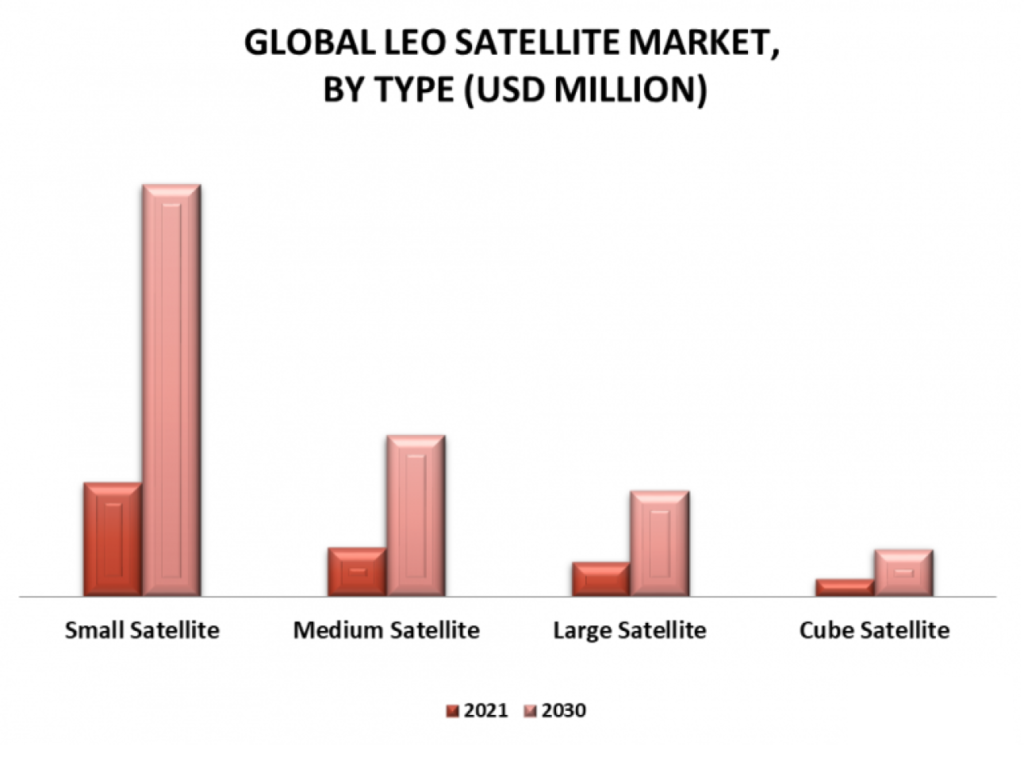
Global LEO Satellite Market Size By Type (Small Satellite, Medium Satellite), By Application (Communication, Earth Observation & Remote Sensing), By End-Users (Commercial Use, Government & Military Use), By Geographic Scope And Forecast
Aerospace & Defence | $3950 | April 2023 | No. of Pages: 202
LEO Satellite Market Size And Forecast
LEO Satellite Market size was valued with a transaction volume of USD 4,955.65 Million in 2021 and is projected to reach USD 16,722.34 Million by 2030, growing at a CAGR of 14.75% from 2023 to 2030.
LEO Satellite Market has been fueled by elements like adaptability, cheap cost, cutting-edge mechanics, simplicity of assembly and launch, mass production, and brief lifecycles. As new technologies advance and more satellites come up, the volume of satellite data and the variety of applications for that data will continue to increase in the future. The Global LEO Satellite Market report provides a holistic evaluation of the market. The report offers a comprehensive analysis of key segments, trends, drivers, restraints, competitive landscape, and factors that are playing a substantial role in the market.
Global LEO Satellite Market Definition
A Low Earth Orbit (LEO) satellite is an object, usually a piece of electronic equipment that orbits the Earth at a lower altitude than geosynchronous satellites. LEO satellites orbit 2000 to 200 km from the Earth. LEO satellites are commonly used for communications, military intelligence, reconnaissance, and other imaging applications. Most of the man-made objects orbiting the Earth are on LEOs. Satellites designed for communications use low signal propagation delay in LEO. This lower propagation delay results in lower latency. Being closer to Earth gives many types of Earth observation satellites the distinct advantage of being able to detect smaller objects with greater detail. LEO satellites have a much smaller contact area than high-altitude satellites. They quickly revolve around the Earth. These factors require satellite clustering for specific applications. A constellation is a group of satellites spaced apart to provide the required coverage. The range of LEO satellites ends where the Mean Earth Orbit (MEO) begins at 2000 km. MEO extends to the limit of geostationary or geosynchronous orbit. Conventional communication technology is placed in geostationary orbit at an altitude of approximately 36,500 km. Because these devices are much smaller than traditional devices, a new way of thinking has emerged that focuses on size, performance, and cost.
Various industrial application of LEO Satellite is as follow Communication, Earth Observation, Logistics and Geo-location, Signal Monitoring, and Scientific Missions. Today, the world is more cloud-based and data-driven. Therefore, there is a growing need to securely and quickly transfer large amounts of data from one point in the world to another. Given these developments, LEO satellites are now focused on providing better data services. Mobile phone operators and providers initially focused on increasing the reach and size of the addressable market. In addition, new services are constantly provided to increase profit and sharing.
Global LEO Satellite Market Overview
The LEO satellite market has gained attention from several industries as it helps in providing high-speed internet without delay, and helps in better earth observation & remote sensing, and research applications. As the world is swiftly shifting towards digitization in combination with the emergence of new Internet of Things (IoT) based devices, used across all industry verticals, the demand for the internet has increased. A significant share of the global population is still not able to access good internet connection or is completely offline; this raises concern about global internet connectivity. To cater to this, key players are constantly taking efforts to boost the launches of LEO satellites to gain better access to the internet. The constant efforts to develop robust digital infrastructure is attracting several governments to initiative programs and fund the LEO satellite development.
These LEO satellites were mostly used to provide better strength compared to MEO and GEO. As these satellites were smaller in size compared to others, their production cost were significantly lower. This attracted the attention of several prominent companies operating into space sector, to introduce their LEO satellites. Honeywell, Starlink, Telesat, and others are some of the key players that launched the LEO satellites for different purpose.
As the technology advanced in combination with favorable investment, several LEO satellites are launched. More than 1500 LEO satellites are present in the LEO space as of 2022. These companies are entering into strategic agreements with other satellite companies or government for gaining approval and support to deploy these LEO Satellites. For instance, in 2021, Phantom Space Corporation and Ingenu joined their hand to manufacture and build and launch 72 low-Earth orbit (LEO) satellites for delivering connectivity for public and enterprise customers. Companies have robust pipeline of launching several LEO satellites to boost the internet connectivity. Rivada Space Networks announced their plans to deploy 600 Low Earth Orbit (LEO) communications satellites by 2028. The deployment shall initiate from 2024 and complete by 2028.
Global LEO Satellite Market: Segmentation Analysis
The Global LEO Satellite Market is segmented on the basis of Type, Application, End-Users, and Geography.
LEO Satellite Market, By Type
- Small Satellite
- Cube Satellite
- Medium Satellite
- Large Satellite

Reasons to Purchase this Report
- Qualitative and quantitative analysis of the market based on segmentation involving both economic as well as non-economic factors.
- Provision of market value (USD Billion) data for each segment and sub-segment.
- Indicates the region and segment that is expected to witness the fastest growth as well as to dominate the market.
- Analysis by geography highlighting the consumption of the product/service in the region as well as indicating the factors that are affecting the market within each region.
- Competitive landscape which incorporates the market ranking of the major players, along with new service/product launches, partnerships, business expansions and acquisitions in the past five years of companies profiled.
- Extensive company profiles comprising of company overview, company insights, product benchmarking and SWOT analysis for the major market players.
- The current as well as the future market outlook of the industry with respect to recent developments which involve growth opportunities and drivers as well as challenges and restraints of both emerging as well as developed regions.
- Includes an in-depth analysis of the market from various perspectives through Porter’s five forces analysis.
- Provides insight into the market through Value Chain.
- Market dynamics scenario, along with growth opportunities of the market in the years to come.
- 6-month post-sales analyst support.
Customization of the Report
- In case of any Queries or Customization Requirements please connect with our sales team, who will ensure that your requirements are met.
Frequently Asked Questions
What is the projected market size & growth rate of the LEO Satellite Market?
What are the key driving factors for the growth of the LEO Satellite Market?
What are the top players operating in the LEO Satellite Market?
What segments are covered in the LEO Satellite Market report?
How can I get a sample report/company profiles for the LEO Satellite Market?
